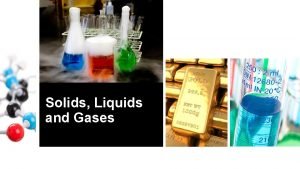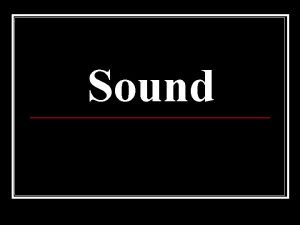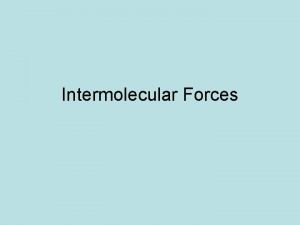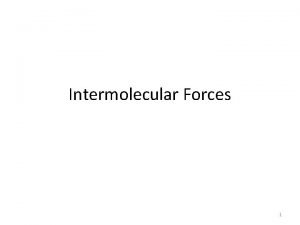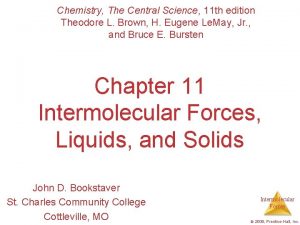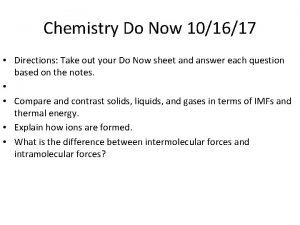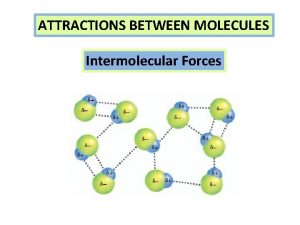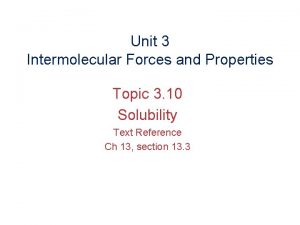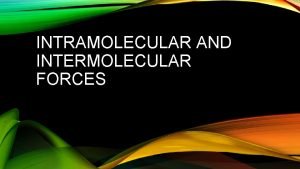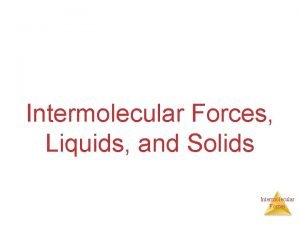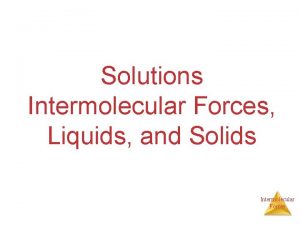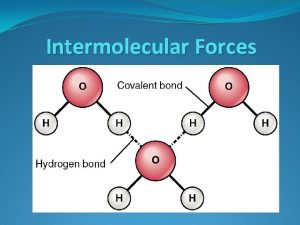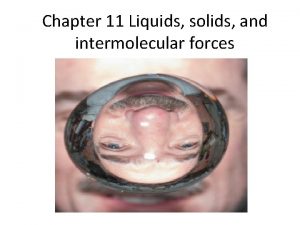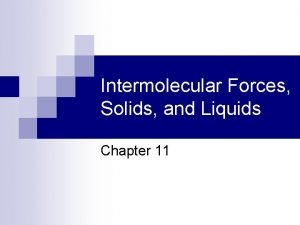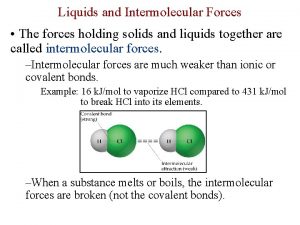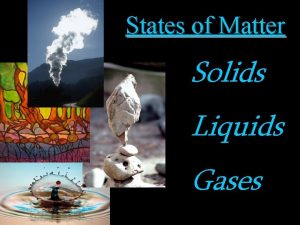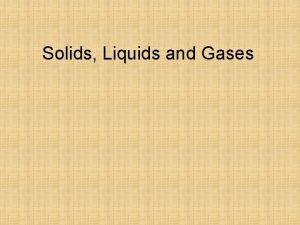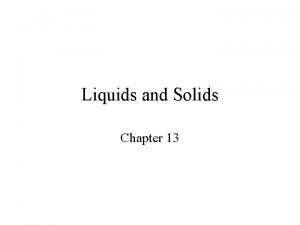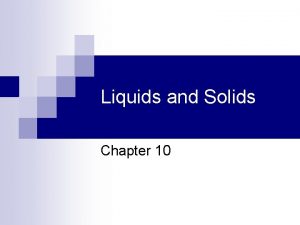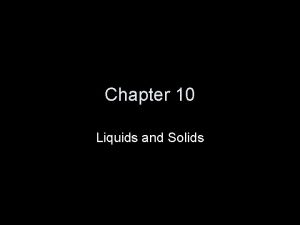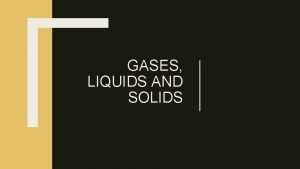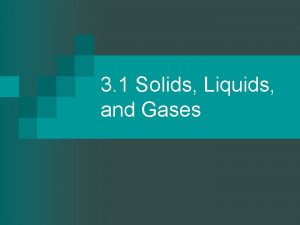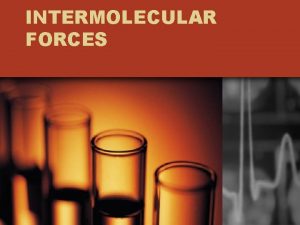Intermolecular Forces Liquids and Solids Intermolecular Forces States































- Slides: 31

Intermolecular Forces, Liquids, and Solids Intermolecular Forces

States of Matter The fundamental difference between states of matter is the distance between particles. Intermolecular Forces

The States of Matter • The state a substance is in at a particular temperature and pressure depends on two things: Ø The kinetic energy of the particles Ø The strength of the attractions between the particles (intermolecular forces) Intermolecular Forces

Properties Intermolecular Forces

Intermolecular Forces Intramolecular forces The attractions between molecules are not nearly as strong as the intramolecular attractions that hold compounds together. (Ionic bonds, covalent bonds, etc. ) Intermolecular Forces

Intermolecular Forces They are, however, strong enough to control physical properties such as boiling and melting points, vapor pressures, and viscosities. Intermolecular Forces

Different Intermolecular Forces • Dipole-dipole interactions • Hydrogen bonding • London dispersion forces Intermolecular Forces

Dipole-Dipole Interactions • Molecules that have permanent dipoles are attracted to each other. Ø The positive end of one is attracted to the negative end of the other and viceversa. Ø These forces are only important when the molecules are close to each other. Intermolecular Forces

London Dispersion Forces/ van der Waals Forces While the electrons in the 1 s orbital of helium would repel each other (and, therefore, tend to stay far away from each other), it does happen that they occasionally wind up on the Intermolecular same side of the atom. Forces

London Dispersion Forces At that instant, then, the helium atom is polar, with an excess of electrons on the left side and a shortage on the right side. Intermolecular Forces

London Dispersion Forces Another helium nearby, then, would have a dipole induced in it, as the electrons on the left side of helium atom 2 repel the electrons in the cloud on helium atom 1. Intermolecular Forces

London Dispersion Forces London dispersion forces, or dispersion forces, are attractions between an induced dipole and an induced dipole. Intermolecular Forces

London Dispersion Forces • These forces are present in all molecules, whether they are polar or nonpolar. • The tendency of an electron cloud to distort in this way is called polarizability. Intermolecular Forces

Hydrogen Bonding • The dipole-dipole interactions experienced when H is bonded to N, O, or F are unusually strong. • We call these interactions hydrogen bonds. • This is what makes water have so many special properties Intermolecular Forces

Hydrogen Bonding Hydrogen bonding arises in part from the high electronegativity of nitrogen, oxygen, and fluorine. Also, when hydrogen is bonded to one of those very electronegative elements, the hydrogen nucleus is exposed. Intermolecular Forces

Which are stronger? • Hydrogen bonding > dipole/dipole > London dispersion forces (induced dipole/ induced dipole) Intermolecular Forces

Intermolecular Forces Affect Many Physical Properties The strength of the attractions between particles can greatly affect the properties of a substance or solution. When the rates of evaporation and condensation are equal, the pressure exerted by the gas molecules above a liquid is called the Intermolecular Forces vapor pressure.

Viscosity • Resistance of a liquid to flow is called viscosity. • It is related to the ease with which molecules can move past each other. • Viscosity increases with stronger intermolecular forces and decreases with higher temperature. Intermolecular Forces

Surface Tension Surface tension results from the net inward force experienced by the molecules on the surface of a liquid. Intermolecular Forces

Phase Changes Intermolecular Forces

Phase Changes Require Energy Release Energy • Melting • Vaporization (boiling) • Sublimation • Freezing • Condensing • Deposition Remember: All phase changes are physical changes! Intermolecular Forces

Phase Diagrams Phase diagrams display the state of a substance at various pressures and temperatures and the places where equilibria exist between phases. Intermolecular Forces

Phase Diagrams • The AB line is the liquid-vapor interface. • It starts at the triple point (A), the point at which all three states are in equilibrium. Intermolecular Forces

Phase Diagrams It ends at the critical point (B); above this critical temperature and critical pressure the liquid and vapor are indistinguishable from each other. Intermolecular Forces

Phase Diagrams Each point along this line is the boiling point of the substance at that pressure. Intermolecular Forces

Phase Diagrams • The AD line is the interface between liquid and solid. • The melting point at each pressure can be found along this line. Intermolecular Forces

Phase Diagrams • Below A the substance cannot exist in the liquid state. • Along the AC line the solid and gas phases are in equilibrium; the sublimation point at each pressure is along this line. Intermolecular Forces

Phase Diagram of Water • Note the high critical temperature and critical pressure: Ø These are due to the strong van der Waals forces between water molecules. Iodine CO 2 Intermolecular Forces

Phase Diagram of Carbon Dioxide Carbon dioxide cannot exist in the liquid state at pressures below 5. 11 atm; CO 2 sublimes at normal pressures. Intermolecular Forces

Solids • We can think of solids as falling into two groups: Ø Crystalline—particles are in highly ordered arrangement. Intermolecular Forces

Solids Ø Amorphous—no particular order in the arrangement of particles. Intermolecular Forces
 Chapter 11 - states of matter: liquids and solids
Chapter 11 - states of matter: liquids and solids Expansion of solids liquids and gases examples
Expansion of solids liquids and gases examples Buoyancyability
Buoyancyability Kinetic molecular theory of solids
Kinetic molecular theory of solids Solid to gas
Solid to gas Venn diagram about solid liquid and gas
Venn diagram about solid liquid and gas Properties of solid, liquid and gas
Properties of solid, liquid and gas Solid liquid gas examples
Solid liquid gas examples Kinetic molecular theory of liquids and solids
Kinetic molecular theory of liquids and solids Liquids and solids menu
Liquids and solids menu Lesson 1 thermal energy and the behavior of matter
Lesson 1 thermal energy and the behavior of matter Chapter 14 solids liquids and gases worksheet answers
Chapter 14 solids liquids and gases worksheet answers Kesler science.com
Kesler science.com Red liquid element
Red liquid element How does sound travel through solids liquids and gases
How does sound travel through solids liquids and gases Matter and its composition
Matter and its composition Motion of particles in solids, liquids and gases
Motion of particles in solids, liquids and gases Explain why gases are easier to compress than liquids.
Explain why gases are easier to compress than liquids. Specific cake resistance formula
Specific cake resistance formula Intramolecular vs intermolecular
Intramolecular vs intermolecular Intra vs intermolecular
Intra vs intermolecular Intermolecular force of attraction
Intermolecular force of attraction Intermolecular forces present in hbr
Intermolecular forces present in hbr Van der waals gecko
Van der waals gecko Intermolecular forces
Intermolecular forces Viscosity and intermolecular forces
Viscosity and intermolecular forces Capillary action and intermolecular forces
Capillary action and intermolecular forces Molecule attraction
Molecule attraction Pg 147
Pg 147 Unit 3 intermolecular forces and properties
Unit 3 intermolecular forces and properties Intermolecular forces and vapor pressure
Intermolecular forces and vapor pressure Electronegativity and intermolecular forces
Electronegativity and intermolecular forces












